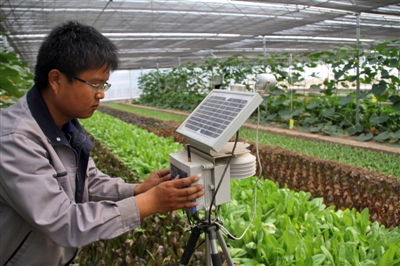(Peoples Daily Online)17:03, July 04, 2019![]()

(Photo/Xinhua)
“Moisture state, photosynthesis, growth rate, fruit weight and size, these can all be transmitted to farmers cellphones by these sensors,” said technician Sun Kai, adding that farmers can compare the data with the optimum conditions for growth, and use their phones to give instructions to add water, fertilizer or adjust other requirements as needed.
Sun has been working in an agricultural science and technology company as a technician for seven years. He installs and debugs Internet of Things (IoT)-based sensors and devices on crops.
IoT-based technologies and sensors have been applied in many agricultural bases across China. They can help test, alert, analyze, and make adjustments to the growing environment of plants, significantly saving water and fertilizer while reducing labor costs.
In the dendrobe planting base of the Internet-based agriculture park of Shishan Town, Haikou City, capital of south China’s Hainan Province, Sun’s team developed specialized algorithms and devices for the base, providing an effective solution to the local conditions.
Considering that dendrobes like a cool and humid environment, and the local area, though endowed with plenty of good quality soil, often suffers from water shortages, Sun’s team developed and installed specialized sensors to detect the moisture content of the plants and a smart irrigation system to irrigate the plants according to their needs.
Thanks to Sun’s team, the IoT-based agricultural park in Dayu Town, Hefei City, capital of east China’s Anhui Province now sees a significant improvement in efficiency as well as a dramatic reduction in irrigation and water costs.
In the past, it took efforts of at least 10 workers to irrigate or apply fertilizer to a vineyard covering an area of 100 mu (One mu equals 0.0667 hectares). Now the job can be taken care of by just one person.
Furthermore, by putting the drip irrigation system into use, people can save 70 percent of the water needed for irrigation. Moreover, applying fertilizer to the root area of the plants helps farmers reduce nearly 60 percent of the fertilizer required.
The company Sun works for has expanded into over 10 provinces in China, covering such areas as planting rice in northeast China’s Heilongjiang Province, an agricultural demonstration park in east China’s Zhejiang Province, greenhouse vegetables in east China’s Jiangsu Province, and tropical agriculture in Hainan Province.
“The installation and debugging of a sensor set can now be done within two to three hours,” said Sun. He explained that preparations used to take at least three days, as his team needed to develop a unique algorithm for each plant species, test the stability of the sensors, and then repeatedly check the data transmission conditions in advance of the installation.
